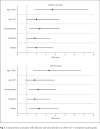Characteristics Associated with Olfactory and Taste Disorders in COVID-19
- PMID: 34198303
- PMCID: PMC8339025
- DOI: 10.1159/000517066
Characteristics Associated with Olfactory and Taste Disorders in COVID-19
Abstract
Introduction: Olfactory and taste disorders (OTDs) have been reported in COVID-19 caused by severe acute respiratory syndrome coronavirus-2 (SARS-CoV-2), the mechanisms of which remain unclear. We conducted a detailed analysis of OTDs as part of 2 seroepidemiological investigations of COVID-19 outbreaks.
Methods: Two retrospective cohort studies were conducted in a high school and primary schools of Northern France following a COVID-19 epidemic in February-March 2020. Students, their relatives, and school staff were included. Anti-SARS-CoV-2 antibodies were identified using a flow-cytometry-based assay detecting anti-S IgG.
Results: Among 2,004 participants (median [IQR] age: 31 [11-43] years), 303 (15.2%) tested positive for SARS-CoV-2 antibodies. OTDs were present in 91 (30.0%) and 92 (30.3%) of them, respectively, and had 85.1 and 78.0% positive predictive values for SARS-CoV-2 infection, respectively. In seropositive participants, OTDs were independently associated with an age above 18 years, female gender, fatigue, and headache.
Conclusion: This study confirms the higher frequency of OTDs in females than males and adults than children. Their high predictive value for the diagnosis of COVID-19 suggests that they should be systematically searched for in patients with respiratory symptoms, fever, or headache. The association of OTDs with headache, not previously reported, suggests that they share a common mechanism, which deserves further investigation.
Keywords: Ageusia; Anosmia; COVID-19; Headache; Severe acute respiratory syndrome coronavirus-2.
© 2021 S. Karger AG, Basel.
Conflict of interest statement
The authors have no conflicts of interest to declare.
Figures
References
-
- Lechien JR, Chiesa-Estomba CM, De Siati DR, Horoi M, Le Bon SD, Rodriguez A, et al. Olfactory and gustatory dysfunctions as a clinical presentation of mild-to-moderate forms of the coronavirus disease (COVID-19): a multicenter European study. Eur Arch Otorhinolaryngol. 2020 Apr;277((8)):2251–61. - PMC - PubMed
-
- Tong JY, Wong A, Zhu D, Fastenberg JH, Tham T. The prevalence of olfactory and gustatory dysfunction in COVID-19 patients: a systematic review and meta-analysis. Otolaryngol Head Neck Surg. 2020;163((1)):3–11. - PubMed
Publication types
MeSH terms
Substances
LinkOut - more resources
Full Text Sources
Medical
Miscellaneous


